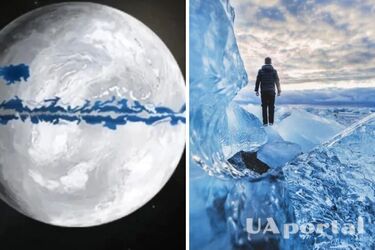Scientists have found out when the next ice age awaits the Earth: you will be amazed

The tilt of the Earth's axis relative to the Sun has played a key role in the formation and disappearance of huge ice sheets over the past 800,000 years, starting and ending eight ice ages.
New research and its discoveries
According to the lead author of the study, Professor of Earth Sciences at Cardiff University Stephen Barker, there is a "surprising correlation" between the Earth's tilt and the formation of ice sheets. Scientists estimate that the next ice age would have occurred in about 11,000 years if not for the impact of global warming. This was reported by Unian.
"According to forecasts, the next glaciation will begin in about 10 thousand years," Barker said. However, this process can be canceled due to high levels of greenhouse gases, which artificially heat the planet and disrupt natural climate cycles.
What are ice ages?
Ice ages are global cooling events that occur every 100 thousand years. At this time, a large part of the planet is covered by thick ice sheets that persist for thousands of years. Between these periods, warmer interglacial phases occur, during which glaciers retreat to the poles. The Earth is currently in just such an interglacial period - the last glacial maximum was about 20 thousand years ago.
Milankovic's theory and new evidence
As early as the 1920s, Serbian scientist Milutin Milankovic suggested that changes in the tilt of the Earth's axis and the shape of the orbit could affect ice cycles. For a century, this theory remained the subject of scientific research.
In particular, in 1976, geologists found that two factors - the Earth's tilt and precession (slow "wobble" of the axis) - play an important role in changing ice cycles. However, the exact mechanics of this process remained unclear.
Barker and his team were finally able to understand this issue.
How does the Earth's tilt affect ice ages?
Currently, the Earth's axis is tilted at an angle of 23.5 degrees, which determines the amount of solar energy that reaches different parts of the planet. However, this tilt changes in a cycle lasting 41 thousand years. At the same time, the Earth's axis oscillates (precession) with a periodicity of 21 thousand years, which affects climatic conditions.
Scientists analyzed changes in tilt and precession over the past 800 thousand years, comparing them with data on glacial expansion and retreat. To do this, they used samples of ocean sediments, in particular microscopic foraminifera shells, which contain information about past climatic conditions.
Impressive results
The researchers found that the expansion of the ice sheets towards the equator is regulated by the tilt of the Earth's axis, while their melting and retreat towards the poles are more dependent on precession.
"The results were a real moment of discovery. We saw a clear link between tilt, precession, and how long it takes for ice sheets to grow or melt," Barker said.
What awaits the Earth in the future?
According to estimates, the next expansion of the ice sheets will begin in about 10-11 thousand years and will last for 80-90 thousand years, reaching its peak. Then the glaciers will begin to retreat, which will take another 10 thousand years.
However, climate models show that human activity has a significant impact on natural processes. CO₂ emissions can disrupt this cycle, delaying or even completely canceling future glaciation.
"If greenhouse gas levels remain high, there may not be a new ice age," Barker concluded.
If you want to get the latest news about the war and events in Ukraine, subscribe to our Telegram channel!
